This page describes the items of the cash flow statement.
It emphasizes understanding the meaning of accounts rather than specialized accounting knowledge.
- Cash Flow Statement
- It is described ‘キャッシュフロー計算書’, and called ‘cash flow keisan syo’, in Japan.
This website describes the cash flow statement based on the description method that is common in Japan,
called the indirect method and the first method.
The cash flow statement mainly consists of cash flows from operating activities, cash flows from investing activities, and cash flows from financing activities.
In the following description, cash flows will be referred to as CF, and the above three cash flows will be referred to as operating CF, investing CF, and financing CF, respectively.
In the cash flow statement, first, the operating CF, investing CF, and financing CF are calculated individually, and the net increase / decrease of cash is calculated by making fine adjustments to the total.
Then, by adding the net increase / decrease of cash to the beginning balance, the ending balance can be obtained.
The cash flow statement contains three types of CFs: operating CF, investment CF, and financial CF.
Since it is easier to explain in simple order, three CFs are explained in the order of financial CF, investment CF, and operating CF.
The financial CF mainly describes proceeds and payments related to loans payable and corporate bonds.
Interest expense are included in net income before taxes as expenses other than the main business, and they are counted in operating CF.
Therefore, the amount stated about them in the financial CF is simply the amount borrowed and the amount repaid.
In addition, financial CF also includes CF through capital transactions with shareholders related to treasury stock, dividends, and capital increases.
Capital transactions are transactions in which capital changes directly between the company and shareholders, and profit or loss is not generated.
Therefore, for items related to capital transactions, the amount received and the amount paid are simply described.
In summary, the financial CF represents only the amount that the company received or paid through its financial activities.
The investment CF mainly describes payments and proceeds from the acquisition and sale of fixed assets.
payments only means paying money, but selling generate profit or loss, and the profit or loss is included in net income before taxes as profit or loss from other than the main business.
In order to process the CF associated with the profit and loss generated by this investing activity, the amount received by the selling is simply described in investing CF, the profit or loss is excluded from the operating CF.
As a result of this process, the cash flow statement only counts the cash inflow by selling, as a whole.
That is, also in the investment CF, only the amount that the company received or paid in the investing activities is described.
However, the amount received in the investing CF has been included the profit or loss generated by investing.
On the other hand, operating CF includes all profit or loss CF that was not included in financing CF or investing CF.
Therefore, in the cash flow statement, the operating CF has the most items and the contents are complicated.
First, the operating CF has a subtotal column, and the items described above and below the subtotal are classified.
Here, first, the upper part of the subtotal column will be explained.
The calculation of operating CF begins with net income before taxes.
Since the taxes such as corporate tax are filed and paid after the closing of accounts, the amount of income taxes-current on the income statement and the amount of tax paid on the cash flow statement do not match.
Therefore, the calculation starts with net income before taxes, not net income.
In the indirect method, first, the profit and loss other than the main business is removed from this net income before taxes, and the amount of income is returned to the operating income.
The relationship between net income before taxes and operating income is expressed by the following formula.
Operating income = Net income before taxes − Profits and Losses other than the main business
That is, operating income can be obtained by excluding profits and losses other than the main business included in net income before taxes.
After the adjustment to return to the operating income, the non-cash items included in profits and losses, which have been used to calculate the operating income, are then adjusted.
the non-cash items included in profits and losses, which have been used to calculate the operating income, are often depreciation, and amortization of goodwill.
There are other non-cash items included in profits and losses, but non-cash items included in profits and losses, from activities other than the main business, are counted in the process of returning net income before taxes to operating income.
Finally, the accounts that show different timings for income / expenses recording and CF generation are adjusted.
The reason why the timing of cash transfer is different from the recording of income and expenses is due to the accrual basis.
Such income and expenses have been recorded as assets or liabilities until the cash transfer is realized.
Therefore, by ccorrecting the increase / decrease in assets / liabilities with different CF timings, it is possible to obtain CF for operating activities.
Accounts with different timings of CF included in profits and losses from the main business are assets such as notes and accounts receivable-trade, merchandise and finished goods, work in process, raw materials and supplies, and liabilities such as notes and accounts payable-trade.
Generally, assets such as merchandise and finished goods, work in process, raw materials and supplies are collectively treated as inventories.
Accounts with different timings of CF, that are included in profit or loss from other than the main business, are assets such as accounts receivable-other and liabilities such as accounts payable-other and accrued expenses.
The above is the explanation of the items described above the subtotal column of the operating CF.
Most of the items included in the profit and loss calculation are included above the subtotal column.
Items that are not included in the investment CF or financial CF, and are not included above the subtotal column of the operating CF are listed below the subtotal column of the operating CF.
The main items below the subtotal column are items related to dividend income and interest, in addition to items related to taxes.
CF related to profit / loss of dividend income and interest has been canceled above the subtotal column, and it is necessary to describe the CF actually generated below the subtotal column.
Tax items are not included in the calculation from the beginning because the calculation start with net income before taxes, and they must be counted.
In other case, special items, such as receiving insurance claims and paying compensation, are listed below the subtotal column.
The above is the explanation of the structure of the cash flow statement. The main points of the cash flow statement are summarized in Figure 2-4-1 (a).
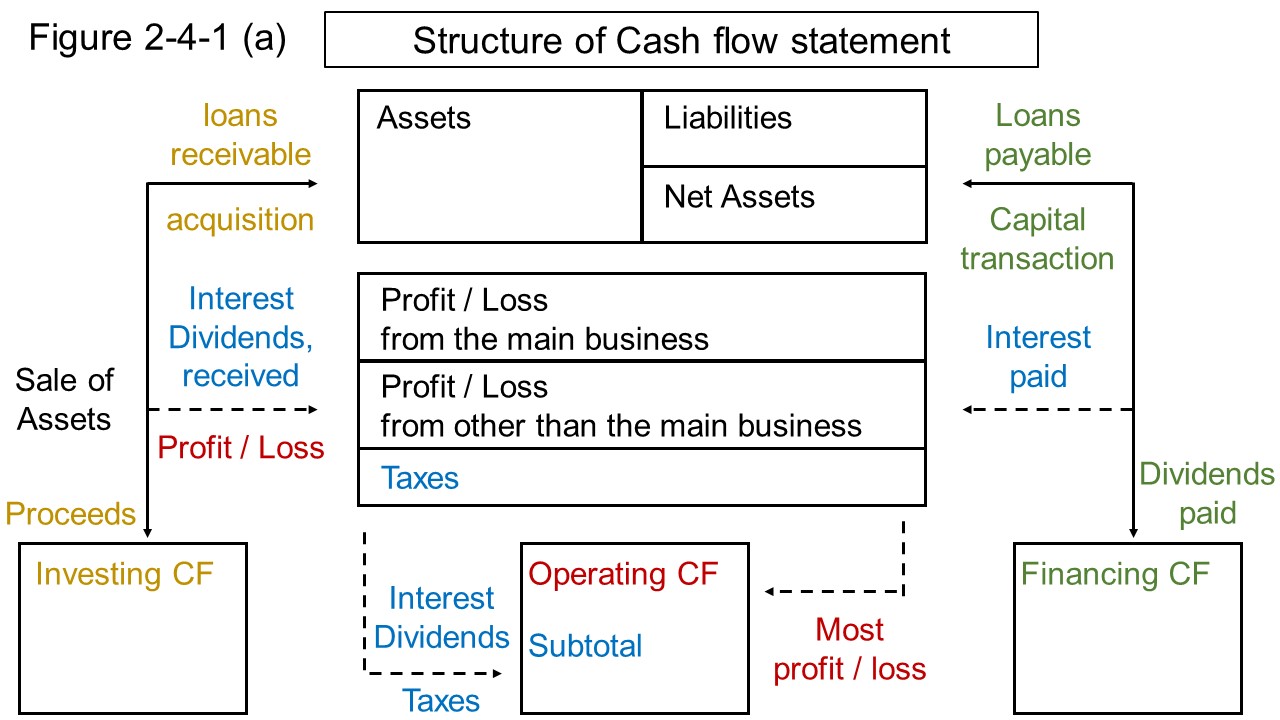
The investing CF and financing CF simply describe the cash inflow and outflow.
And most of the CF related to profit and loss is listed above the subtotal column of the operating CF.
Below the subtotal column of operating CF, CFs not included above the subtotal column for investment CF, financial CF, and operating CF are listed.
As a result, in general, CFs related to profit and loss of the main business are listed in the subtotal column of operating CF, and CFs related to investments other than the main business are listed in the investment CF.
And, CFs related to profit and loss generated by financing activities other than the main business is listed below the subtotal column of operating CF.
Althugh there are some items do not appear explicitly on the income statement, such as depreciation, items on the cash flow statement are basically related to the accounts used in the income statement and balance sheet.
Financing CF includes items related to treasury stock and dividends, in addition to borrowings from banks and corporate bonds.
Investing CF includes items related to investment such as securities managed over the long term, time deposits, and loans, in addition to capital investment.
In the operating CF, the accounts used in the profit and loss calculation are adjusted to represent actual inflow and outflow of cash.
Therefore, many items are described in the operating CF.
- Cash flows from operating activities
- It is described ‘営業活動によるキャッシュフロー’, and called ‘eigyou katsudou ni yoru cash flow’, in Japan.
Operating CF roughly includes the following.
Many CF items are included in operating CF, but they are items for adjusting so that the operating CF represents the profit from the main business as a whole.
- CFs related to the main business
- CFs that are listed below the subtotal, unrelated to the main business and not counted in investing CF and financing CF
- CFs that are excluded above the subtotal to avoid double counting with CF from financing and investing activities
In the operating CF, CFs related to the main business are listed above the subtotal column, and CFs that are not related to the main business and are not included in the investing CF and financing CF are listed below the subtotal column.
And, in the subtotal column, the total of CF related to the main business is described.
On the other hand, below the subtotal column, items related mainly to dividend income, interest and taxes are listed.
Therefore, the amount in the subtotal column can be regarded as the CF earned by the main business, and the amount of operating CF can be regarded as the CF including the expenses required for business operation.
Of course, it is desirable that the entire operating CF is positive, but it is particularly desirable that the subtotal column is positive.
However, there is a time lag in collecting the profit or loss generated in accounting as cash.
Therefore, even if the operating income is positive, the operating CF may be negative, or even if the operating income is negative, the operating CF may be positive.
Nonetheless, revenues and expenses and cash inflows and outflows should finally match.
Companies that continue to show negative operating CF despite profits may have problems such as dependence on borrowing.
- Income before income taxes (Net income before taxes)
- It is described ‘税金等調整前純利益’, and called ‘zeikin tou tyousei mae jyun rieki’, in Japan.
In the calculation method called the indirect method, the top of the CF statement is income before income taxes.
In the indirect method, cash flow is calculated by excluding the amount of the account that is included in the profit and loss calculation but the cash has not moved, from the income before income taxes.
Note that, this account is generally described as income before income taxes in the Japanese cash flow statement, but this website uses the notation net income before taxes.
- Depreciation
- It is described ‘減価償却費’, and called ‘genka syoukyaku hi’, in Japan.
Depreciation is what the purchase price of a fixed asset is divided and recorded as the cost according to its useful term.
That is, it is the cost recorded every year even if all price of the asset is paid when the asset is purchased and then not paid.
Although it was counted as a cost in the income statement, the amount is added to the income before income taxes in the CF statement because the cash has not decreased.
In other words, depreciation reduces on annual profits, but means that there is always no cash outflow for the amount.
That is, companies have been earned more cash of the depreciation than the operating income.
This is an important point in determining the value of a companies or stocks based on cash flow, not profit.
Therefore, depreciation is a particularly important item among the items described in the cash flow statement.
- Impairment loss
- It is described ‘減損損失’, and called ‘genson sonshitsu’, in Japan.
Impairment loss is the devaluation of the book value of an asset, which is recorded as an expense in the income statement, when it becomes impossible to expect income from the asset.
Since it was artificially recognized as a loss and the cash has not decreased, that amount will be added in the CF statement.
- Amortization of goodwill
- It is described ‘のれんの償却額’, and called ‘noren no syoukyaku gaku’, in Japan.
Amortization of goodwill is to reduce the book value of goodwill on a regular basis and record the amount as an expense.
With the same theory as depreciation, cash has not decreased, and that amount is added to income before income taxes.
However, it should be noted that this is true for Japanese GAAP, but not for IFRS.
Goodwill is amortized evenly under Japanese GAAP, but it is not amortized under IFRS.
Under IFRS, the book value of goodwill is kept without amortization, and goodwill is treated as an impairment in the event of a problem with the acquiring company.
- Increase / decrease in allowance for doubtful accounts
- It is described ‘貸倒引当金の増減額’, and called ‘kashidaore hikiate kin no zougen gaku’, in Japan.
An increase in the allowance for doubtful accounts on the balance sheet means that the provision of allowance for doubtful accounts was recorded as an expense on the income statement while keeping the amount of accounts receivable of the asset.
In short, the provision of allowance for doubtful accounts has been counted in the income before income taxes as artificial expense.
Since the cash equivalent to the provision of allowance for doubtful accounts has not decreased, that amount will be added to income before income taxes.
Conversely, a decrease in the allowance for doubtful accounts means that the reversal of allowance for doubtful accounts was recorded as a profit while keeping the amount of accounts receivable of the assets.
In this case, although it is a profit, cash has not been obtained, so that amount is deducted from income before income taxes.
This is showed by (△ is a decrease), and the negative presentation of CF means a decrease in in allowance for doubtful accounts.
A schematic picture is shown in Figure 2-4-1 (b).
The arrows on the balance sheet show the increase / decrease in the account, and the + and − in the CF statement show the increase / decrease in the cash.
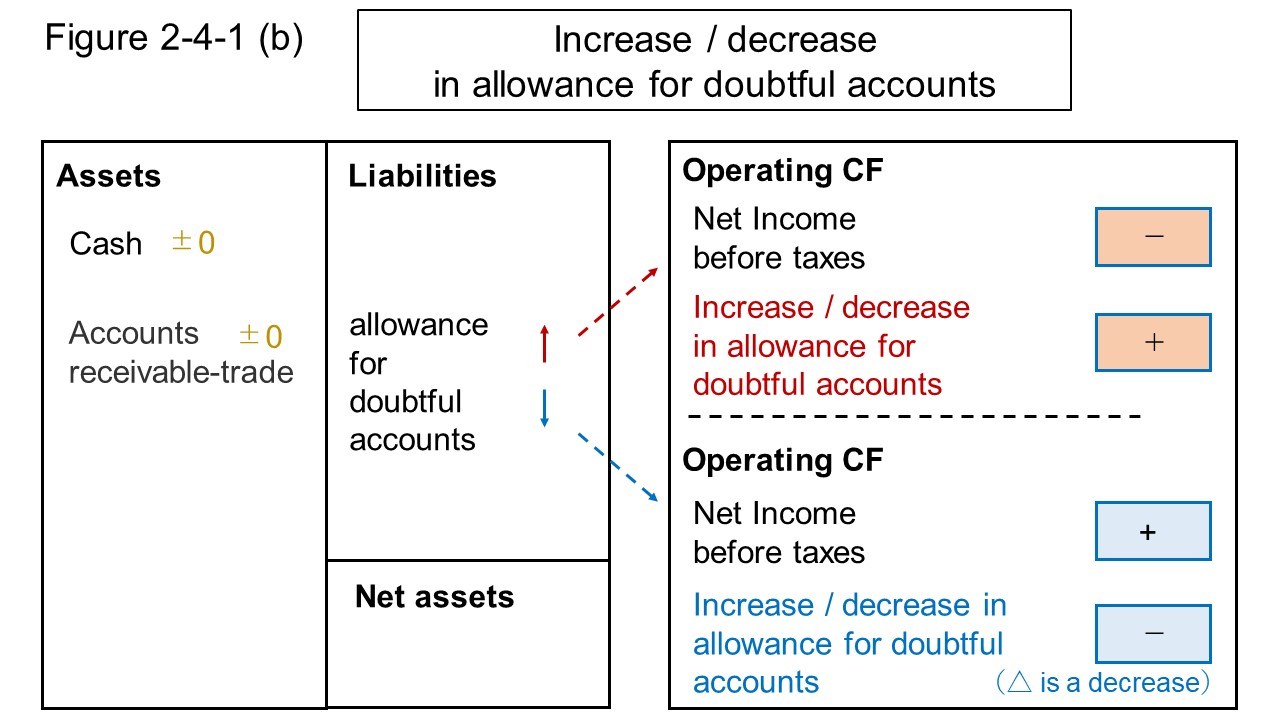
The theory is the same for other provisions.
- Interest and dividend income
- It is described ‘受取利息及び受取配当金’, and called ‘uketori risoku oyobi uketori haitoukin’, in Japan.
Interest income and dividend income are listed below the subtotal in operating CF.
On the other hand, they are included in income before income taxes.
Therefore, what is removed to avoid double counting is the interest and dividend income listed above the subtotal in operating CF.
- Interest expenses
- It is described ‘支払利息’, and called ‘shiharai risoku’, in Japan.
Interest expense is listed below the subtotal in operating CF.
The amount adjusted to avoid double counting in operating CF is the interest expense listed above the subtotal.
- Loss / gain on sales of investment securities
- It is described ‘投資有価証券売却損益’, and called ‘toushi yuuka syouken baikyaku son eki’, in Japan.
The sale of investment securities generates cash inflow, and the profit or loss is included in income before income taxes.
However, since the inflow is recorded in the investment CF, if the loss / gain have been included in the operating CF, it will be double-recorded for cash.
Therefore, what the loss / gain is excluded from income before income taxes is the loss / gain on sales of investment securities in the operating CF
As shown in Figure 2-4-1 (c), if the profit and loss is positive, cash will be negative, so (△ is gain) will be displayed.
In other words, the positive CF presentation of loss / gain on investment securities in operating CF means a loss.
Since profits and losses other than the main business are canceled in the operating CF, if there is a profit, the CF in the operating CF will be negative.
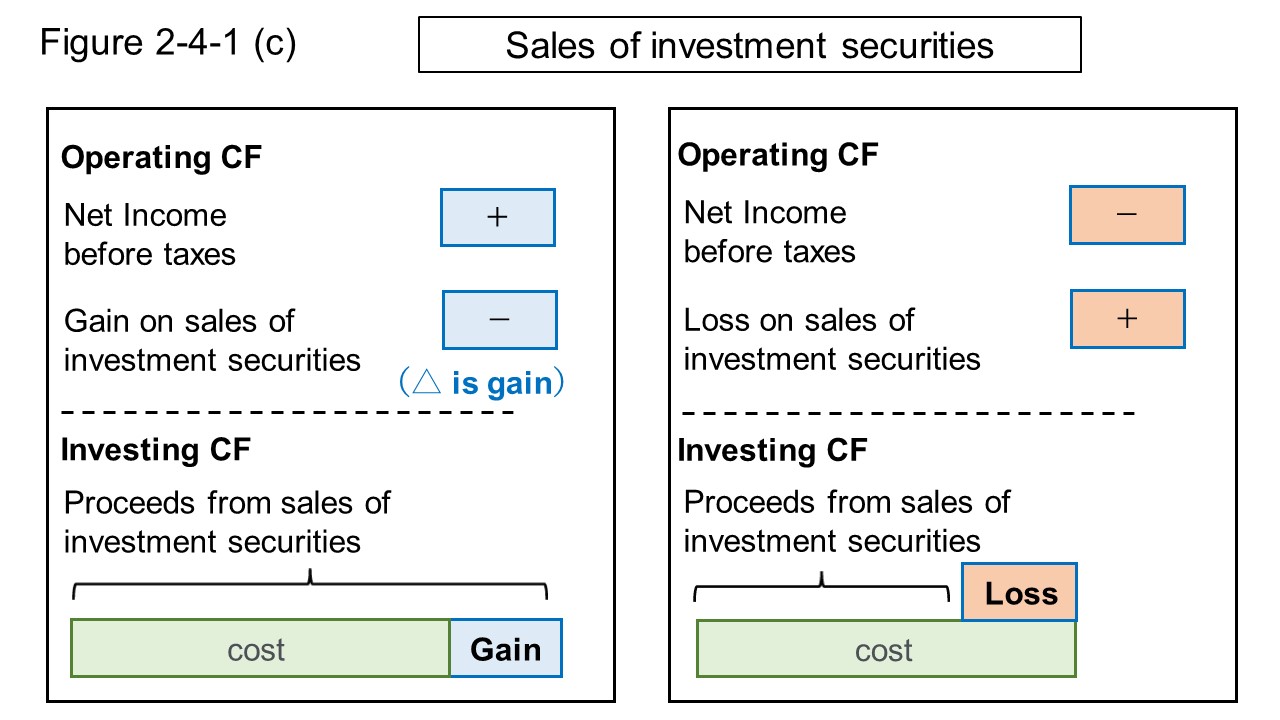
- Loss / gain on sales of non-current assets
- It is described ‘固定資産売却損益’, and called ‘kotei shisan baikyaku son eki’, in Japan.
The relationship between loss / gain and changes in cash, on sales of non-current assets in operating CF, is the same as loss / gain on sales of investment securities.
If it is gain, it shows negative cash flow (△ is gain), and if it is loss, it shows positive cash flow, as shown in Figure 2-4-1 (d).
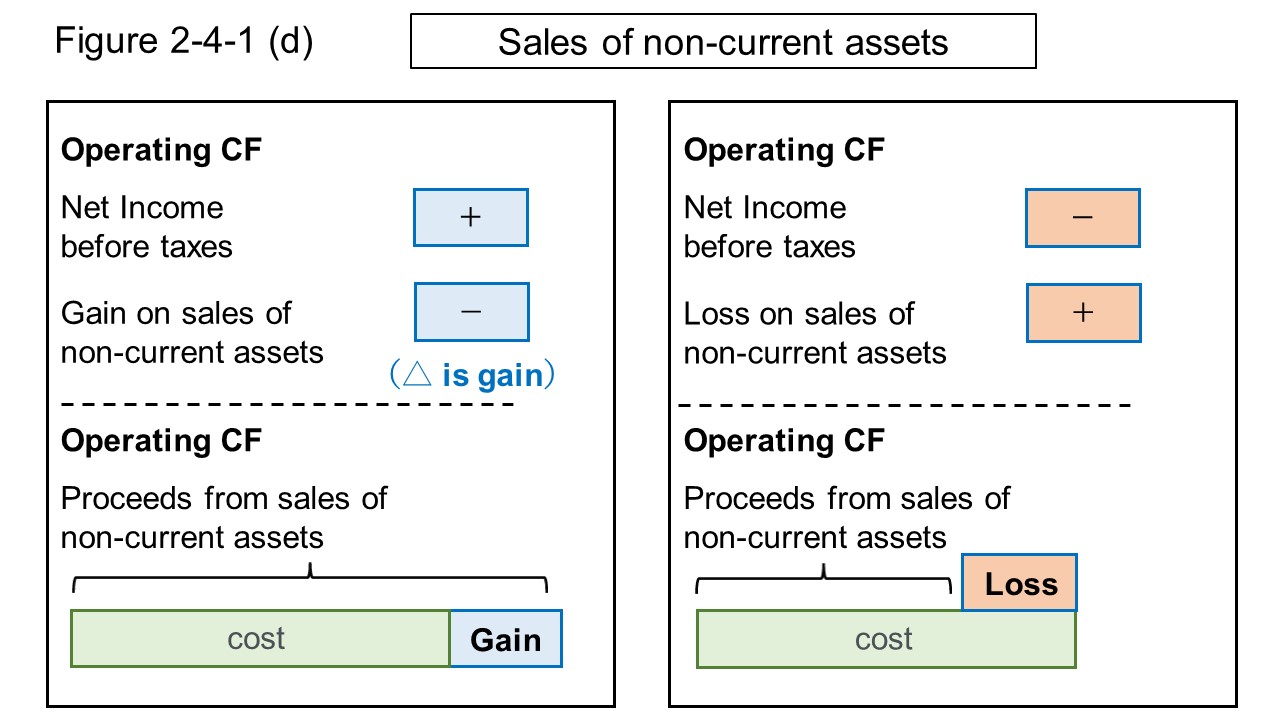
- Decrease / increase in notes and accounts receivable - trade
- It is described ‘売上債権の増減額’, and called ‘uriage saiken no zougen gaku’, in Japan.
The increase in trade receivables for the current period shows the sales for the current period that have not been collected as cash.
Therefore, although it is counted as a plus to income before income taxes, the cash has not increased.
Since the amount of cash that has not increased is calculated to minus, it is displayed as (△ is an increase).
Conversely, decrease in notes and accounts receivable - trade means that cash for sales could be collected.
A schematic picture is shown in Figure 2-4-1 (e).
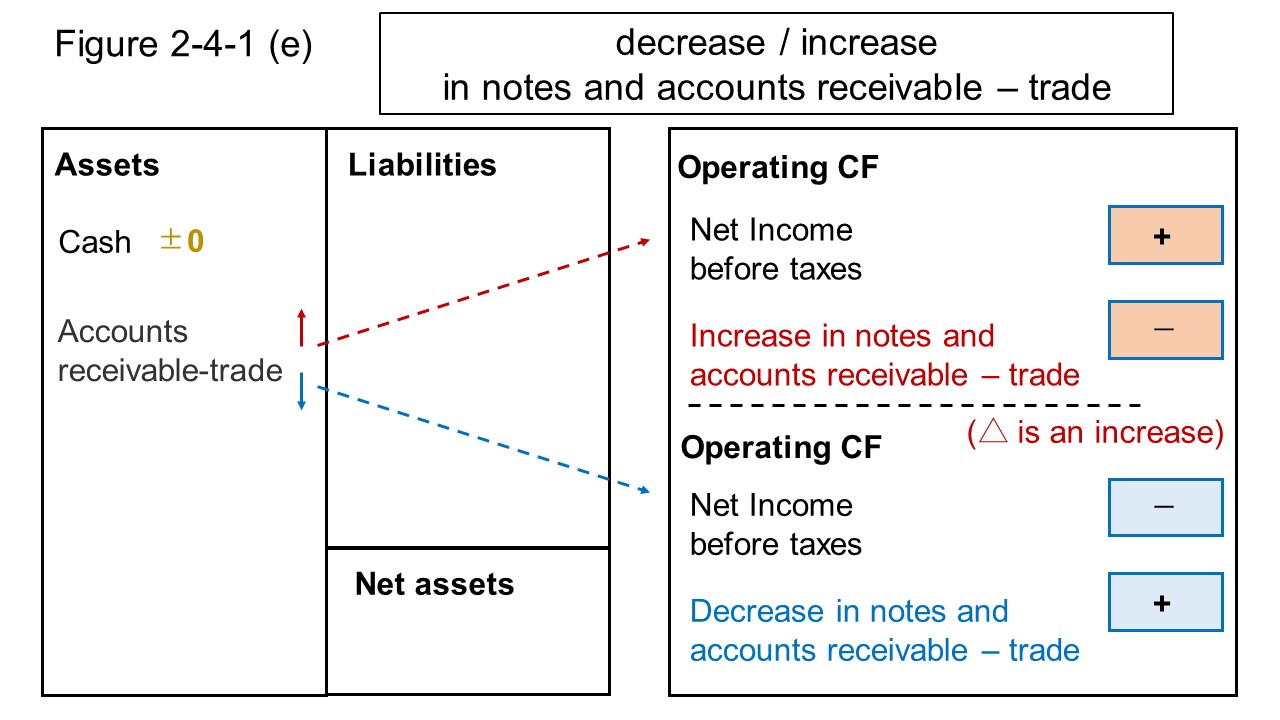
- Increase / decrease in notes and accounts payable - trade
- It is described ‘仕入債務の増減額’, and called ‘shiire saimu no zougen gaku’, in Japan.
Notes and accounts payable - trade are unpaid debts, and even if they increase, the cash does not decrease.
Therefore, it is necessary to calculate the cash corresponding to the increase in notes and accounts payable - trade as a plus.
Although increase in notes and accounts payable - trade has generated inventories, it is adjusted separately.
Conversely, decrease in notes and accounts payable - trade means that the debt has been cleared with cash.
Since the decrease of cash is calculated as a minus, (△ is a decrease) is displayed.
A schematic picture is shown in Figure 2-4-1 (f).

- Decrease / increase in inventories
- It is described ‘棚卸資産の増減額’, and called ‘tanaoroshi shisan no zougen gaku’, in Japan.
Increase in inventories for the current period means that unsold inventories have increased.
Unsold inventories do not contribute to cost of sales and do not affect income before income taxes.
Increase in notes and accounts payable - trade, which results in an increase in inventories, is adjusted separately, so counting the increase in inventories is consistent with the decrease in cash.
Therefore, (△ is an increase) is shown.
Conversely, decrease in inventories for the current period contributes to the cost of sales and therefore affects the income before income taxes.
However, the cost of inventories other than notes and accounts payable - trade has already been paid, and cash does not decrease.
Therefore, it is necessary to count the cash corresponding to the decrease in inventories as a plus.
A schematic picture is shown in Figure 2-4-1 (g).
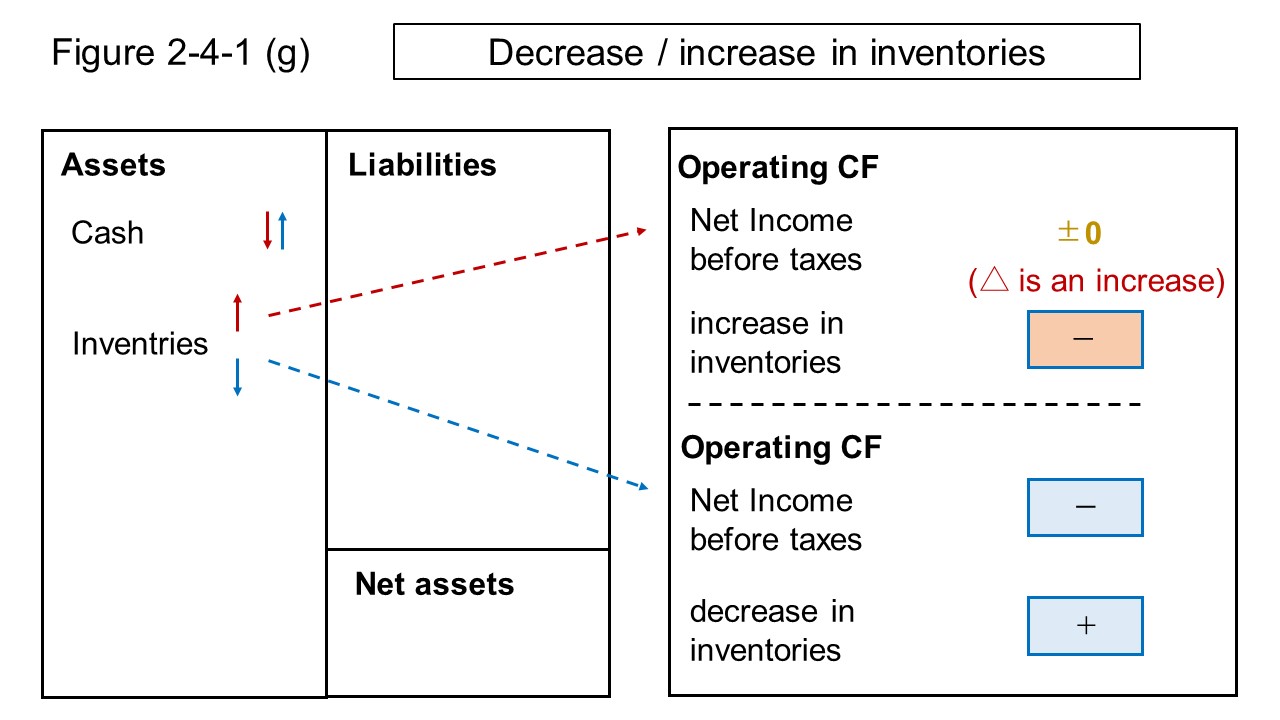
- Subtotal
- It is described ‘小計’, and called ‘syoukei’, in Japan.
In the method of describing the CF statement called the first method, an item called subtotal appears in the column of operating CF.
CF related to the main business is listed above the subtotal, and CF not included in investing CF or financing CF that is not related to the main business is listed below the subtotal.
- Interest and dividend income received
- It is described ‘利息及び配当金の受取額’, and called ‘risoku oyobi haitou kin no uketori gaku’, in Japan.
Interest and dividend income received is the income that is not related to the main business, but it is listed below the subtotal of the operating CF because it is not included in the investing CF and financing CF.
However, since this income is included in income before income taxes as non-operating income, it is necessary to remove that amount once.
The removed amount is described as a negative cash flow above the subtotal, and after adjusting the deferred and accrued accounts, the cash received is described below the subtotal.
Adjusting the deferred and accrued accounts is to adjust for the timing difference between revenue and cash inflow.
CF is positive under subtotal because cash is simply received.
- Interest expenses paid
- It is described ‘利息の支払額’, and called ‘risoku no shiharai gaku’, in Japan.
Interest expenses paid is cost that is not related to the main business, but it is listed below the subtotal of the operating CF because it is not included in the investing CF and financing CF.
However, since this cost is included in income before income taxes as non-operating expense, it is necessary to remove that amount once.
The removed amount is described as a positive cash flow above the subtotal, and after adjusting the deferred and accrued accounts, the cash paid is described below the subtotal.
CF is negative under subtotal because cash is simply paid.
- Income taxes paid / refund
- It is described ‘法人税等の支払額又は還付額’, and called ‘houzin zei tou no shiharai gaku matawa kanpu gaku’, in Japan.
Income taxes paid / refund is listed below the subtotal of the operating CF because it is not counted in income before income taxes and it is not included in the investing CF and financing CF.
If corporate tax, etc. is paid, the cash will decrease, so (△ is expenditure) is displayed.
Since the amount of corporate tax, etc. will be fixed after the closing, the payment of corporate tax, etc. that occurred in the current fiscal year will be paid in the next fiscal year except for the interim payment.
Therefore, the tax amounts described in the income statement and the cash flow statement do not match.
- Cash flows from investing activities
- It is described ‘投資活動によるキャッシュフロー’, and called ‘toushi katsudou ni yoru cash flow’, in Japan.
Investing CF is a CF mainly related to investment in fixed assets.
Investing CF includes not only expenditures on fixed assets but also income from the sale of them.
- Payments into time deposits
- It is described ‘定期預金の預入による支出’, and called ‘teiki yokin no azukeire ni yoru shisyutsu’, in Japan.
- Proceeds from withdrawal of time deposits
- It is described ‘定期預金の払戻による収入’, and called ‘teiki yokin no haraimodoshi ni yoru syuunyuu’, in Japan.
Payments into time deposits or proceeds from withdrawal of time deposits is expenditures or income related to time deposits with a maturity of more than 3 months.
Cash in the CF statement is cash and cash equivalents, and time deposits with a maturity of 3 months or less from the beginning of setting are included in the concept of cash.
Therefore, time deposits with a maturity of 3 months or less are not dscribed in the cash flow statement.
However, since time deposits with a maturity of more than 3 months are not included in the concept of cash, the cash flow generated by them is described in the investment CF.
- Purchase of property, plant and equipment
- It is described ‘有形固定資産の取得による支出’, and called ‘yuukei kotei shisan no syutoku ni yoru shisyutsu’, in Japan.
- Proceeds from sales of property, plant and equipment
- It is described ‘有形固定資産の売却による収入’, and called ‘yuukei kotei shisan no baikyaku ni yoru syuunyuu’, in Japan.
“Purchase of property, plant and equipment” or “proceeds from sales of property, plant and equipment” is the CF generated when the property, plant and equipment is acquired or sold.
CF due to acquisition or expenditure of fixed assets is to be listed in investment CF.
The same item may appear in the operating CF, but this is a process to prevent double counting in the CF statement.
⇒ Loss / gain on sales of non-current assets
- Purchase of intangible assets
- It is described ‘無形固定資産の取得による支出’, and called ‘mukei kotei shisan no syutoku ni yoru shisyutsu’, in Japan.
- Proceeds from sales of intangible assets
- It is described ‘無形固定資産の売却による収入’, and called ‘mukei kotei shisan no baikyaku ni yoru syuunyuu’, in Japan.
Purchase of intangible assets or Proceeds from sales of intangible assets is the CF generated when the intangible fixed assets are acquired or sold.
The processing in the CF statement is the same as for property, plant and equipment.
- Purchase of investment securities
- It is described ‘投資有価証券の取得による支出’, and called ‘toushi yuuka syouken no syutoku ni yoru shisyutsu’, in Japan.
- Proceeds from sales of investment securities
- It is described ‘投資有価証券の売却による収入’, and called ‘toushi yuuka syouken no baikyaku ni yoru syuunyuu’, in Japan.
Purchase of investment securities or proceeds from sales of investment securities is the CF generated when the investment securities are acquired or sold.
The amount of expenditure or income is described as investment CF.
In the case of sales of investment securities, the profit and loss portion must be excluded from the operating CF because they are included in the income before income taxes.
⇒ Loss / gain on sales of investment securities
- Purchase of shares of subsidiaries
- It is described ‘子会社株式の取得による支出’, and called ‘ko gaisya kabushiki no syutoku ni yoru shisyutsu’, in Japan.
Purchase of shares of subsidiaries is the cash outflow associated with the acquisition of the subsidiary.
However, the cash held by the subsidiary from the time of acquisition will be deducted.
- Purchase of shares of subsidiaries resulting in change in scope of consolidation
- It is described ‘連結範囲の変更を伴う子会社株式の取得に伴う支出’, and called ‘renketsu han-i no henkou wo tomonau ko gaisya kabushiki no syutoku ni tomonau shisyutsu’, in Japan.
Purchase of shares of subsidiaries resulting in change in scope of consolidation are cash outflows when additional shares are purchased and made into a subsidiary with a change in the scope of consolidation.
However, the cash held by the subsidiary from the time of the change will be deducted.
- Payments of loans receivable
- It is described ‘貸付による支出’, and called ‘kashitsuke ni yoru shisyutsu’, in Japan.
- Collection of loans receivable
- It is described ‘貸付金の回収による収入’, and called ‘kashitsuke kin no kaisyuu ni yoru shisyutsu’, in Japan.
Payments of loans receivable or collection of loans receivable are cash outflows or inflows relating to the loan, respectively.
Loans mean loans to affiliated companies and business partners, and only the principal is counted in the investment CF.
CFs related to interest income and interest expense are listed below the subtotal in operating CF
- Cash flows from financing activities
- It is described ‘財務活動によるキャッシュフロー’, and called ‘zaimu katsudou ni yoru cash flow’, in Japan.
Financing CF includes mainly CF related to borrowing and repayment of debts, and CF related to capital transactions with shareholders.
- Net increase / decrease in short-term loans payable
- It is described ‘短期借入金の純増減額’, and called ‘tanki kariire kin no jyun zou gen gaku’, in Japan.
short-term loans payable are loans whose payment deadline is within one year from the closing.
Net increase / decrease in short-term loans payable is the difference between the end-of-term balance and the beginning balance of short-term borrowings.
A decrease in the balance, that is, a net decrease, indicates that the short-term borrowing has been repaid as a whole, resulting in a decrease in cash.
Therefore, it is described as (△ is a decrease).
- Net increase / decrease in commercial papers
- It is described ‘コマーシャル・ペーパーの純増減額’, and called ‘commercial paper no jyun zou gen gaku’, in Japan.
Commercial papers are short-term, unsecured promissory notes issued by a company to raise funds.
Interest rates are determined by the creditworthiness of the company.
Net increase / decrease in commercial papers is the difference between the end-of-term balance and the beginning balance of the commercial paper.
A decrease in the balance, that is, a net decrease, indicates that the commercial paper has been repaid as a whole, resulting in a decrease in cash.
Therefore, it is described as (△ is a decrease).
- Proceeds from long-term loans payable
- It is described ‘長期借入れによる収入’, and called ‘tyouki kariire ni yoru syuunyuu’, in Japan.
- Repayments of long-term loans payable
- It is described ‘長期借入金の返済による支出’, and called ‘tyouki kariire kin no hensai ni yoru shisyutsu’, in Japan.
Long-term loans payable is borrowing whose payment deadline is more than one year from the closing.
Proceeds from long-term loans payable or repayments of long-term loans payable is the CF for borrowing or repayment of long-term debt, respectively.
- Proceeds from issuance of bonds
- It is described ‘社債の発行による収入’, and called ‘syasai no hakkou ni yoru syuunyuu’, in Japan.
- Redemption of bonds
- It is described ‘社債の償還による支出’, and called ‘syasai no syoukan ni yoru shisyutsu’, in Japan.
Bonds here are corporate bonds issued by a company.
Proceeds from issuance of bonds or redemption of bonds is CF associated with the issuance or redemption of corporate bonds, respectively.
- Purchase of treasury shares
- It is described ‘自己株式の取得による支出’, and called ‘ziko kabushiki no syutoku ni yoru shisyutsu’, in Japan.
- Proceeds from disposal of treasury shares
- It is described ‘自己株式の処分による収入’, and called ‘ziko kabushiki no syobun ni yoru syuunyuu’, in Japan.
Purchase of treasury shares or proceeds from disposal of treasury shares is the CF generated by acquiring or selling the treasury shares, respectively.
It should be noted that disposal of treasury shares means that the company sells treasury shares, and the total number of issued shares does not change.
Reducing the total number of issued shares is called such as cancellation, retirement, or extinguishment of shares.
- Cash dividends paid
- It is described ‘配当金の支払額’, and called ‘haitou kin no shiharai gaku’, in Japan.
- Dividends paid to non-controlling interests
- It is described ‘非支配株主への配当金の支払額’, and called ‘hi shihai kabunushi weno haitou kin no shiharai gaku’, in Japan.
The former is approximately the cash outflow resulting from the payment of dividends of the financial statement submitting company which is the parent company.
To be precise, cash dividends paid is what the dividend paid by the parent company is offset by the interest and dividends received by the parent company from the subsidiary and the non-controlling interests are excluded.
The latter is the dividends that was excluded from cash dividends paid and was paid to the non-controlling interests of the subsidiary.
- Payments from changes in ownership interests in subsidiaries that do not result in change in scope of consolidation
- It is described ‘連結の範囲の変更を伴わない子会社株式の取得による支出’, and called ‘renketsu no han-i no henkou wo tomonawa nai ko gaisya kabushiki no syutoku ni yoru shisyutsu’, in Japan.
- Proceeds from changes in ownership interests in subsidiaries that do not result in change in scope of consolidation
- It is described ‘連結範囲の変更を伴わない子会社株式の売却による収入’, and called ‘renketsu no han-i no henkou wo tomonawa nai ko gaisya kabushiki no baikyaku ni yoru syuunyuu’, in Japan.
The former is the CF associated with the acquisition of shares by the parent company from a non-controlling interest in the subsidiary.
On the other hand, the latter is the CF associated with the selling of shares of the subsidiary within the range in which the parent company keep the control for the subsidiary.
Under accounting standards, CF associated with the purchase or sale of subsidiary stock is divided into investment CF and financial CF depending on whether or not the scope of consolidation is changed.
Of these, the amount of the subsidiary stock by purchase or sale, without changing the scope of consolidation, is stated in the financial CF.
If there is a change in the scope of consolidation, it means that the control is acquired or sold, and it will be included in the CF through investment activities in the same way as the acquisition and sale of fixed assets.
The balance at the end of the period is calculated based on the balance at the beginning of the period and the operating CF, investing CF, and financing CF of the current period.
Fine adjustments are made in the calculation.
- Effect of exchange rate change on cash and cash equivalents
- It is described ‘現金及び現金同等物に係る換算差額’, and called ‘genkin oyobi genkin doutou butsu ni kakaru kansan sagaku’, in Japan.
Effect of exchange rate change on cash and cash equivalents is the foreign exchange gain or loss on cash and cash equivalents in foreign currencies.
It generates when converting cash and cash equivalents of overseas subsidiaries and deposits denominated in foreign currencies into yen.
If there is a profit in yen conversion, it will be positive, and if there is a loss, it will be negative.
- Net increase / decrease in cash and cash equivalents
- It is described ‘現金及び現金同等物の増減額’, and called ‘genkin oyobi genkin doutou butsu no zou gen gaku’, in Japan.
Net increase / decrease in cash and cash equivalents is calculated by the following formula.
Net increase / decrease in cash and cash equivalents = Operating CF + Investing CF + Financing CF + Effect of exchange rate change on cash and cash equivalents
- Cash and cash equivalents at beginning of period
- It is described ‘現金及び現金同等物の期首残高’, and called ‘genkin oyobi genkin doutou butsu no kisyu zandaka’, in Japan.
Cash and cash equivalents at beginning of period is the balance of cash and cash equivalents at the beginning of the period.
- Increase / decrease in cash and cash equivalents resulting from change of scope of consolidation
- It is described ‘連結の範囲の変更に伴う現金及び現金同等物の増減額’, and called ‘renketsu no han-i no henkou ni tomonau genkin oyobi genkin doutou butsu no zou gen gaku’, in Japan.
Increase / decrease in cash and cash equivalents resulting from change of scope of consolidation is the addition of the cash and cash equivalents of the subsidiary at the start of consolidation to the opening balance of the parent company when the non-consolidated subsidiary becomes a consolidated subsidiary.
- Cash and cash equivalents at end of period
- It is described ‘現金及び現金同等物の期末残高’, and called ‘genkin oyobi genkin doutou butsu no kimatsu zandaka’, in Japan.
Cash and cash equivalents at end of period is the sum of ‘cash and cash equivalents at beginning of period’, ‘net increase / decrease in cash and cash equivalents’, and ‘increase / decrease in cash and cash equivalents resulting from change of scope of consolidation’.